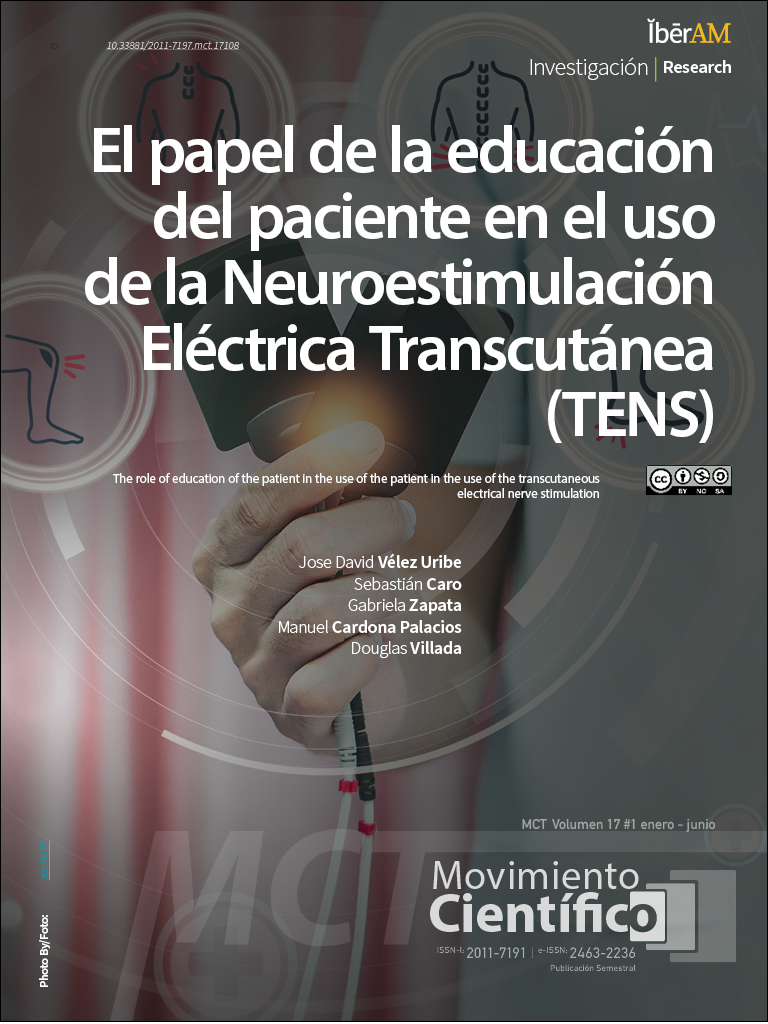The role of education of the patient in the use of the transcutaneous electrical nerve stimulation
El papel de la educación del paciente en el uso de la Neuroestimulación Eléctrica Transcutánea (TENS)
Main Article Content
Pain represents a very prevalent condition. It affects people's health, productivity, performance in daily life activities and increases economic costs, both for health entities and for the people themselves. Transcutaneous electrical nerve stimulation (TENS) is a tool known for its ability to generate analgesia. The proper and standardized use of this instrument is still under review. Its effect is enhanced when, in addition to the health professional, the patient understands its use and application. Objective: To review through the literature the role of education in the use of TENS and to suggest a proposal for training patients to enable its proper use. Methodology: literature review through Pubmed, Clinicalkey, Chrocane, Scielo, ScienceDirect, Sportdiscus and PEDRO databases, between February and April 2023. Conclusion: Although no specific studies on patient education in the use of TENS were found, there is scientific evidence that supports its therapeutic effect and the importance for the patient to understand its use, in addition to highlighting the role of education in general health processes and their repercussions. For this reason, a proposal for patient education on the use of the current was developed, which covers the understanding of its operation and allows interaction in everyday situations of its applicability, in order to respond to the suggestions found in health education.
Downloads
Publication Facts
Reviewer profiles N/A
Author statements
Indexed in
-
—
- Academic society
- N/A
- Publisher
- Bogotá: Corporación Universitaria Iberoamericana
Article Details
Aj, W., Cp, van W., M, M., & J, N. (2016). Clinical biopsychosocial physiotherapy assessment of patients with chronic pain: The first step in pain neuroscience education. Physiotherapy Theory and Practice, 32(5), Article 5. https://doi.org/10.1080/09593985.2016.1194651 DOI: https://doi.org/10.1080/09593985.2016.1194651
Arce Galvez, L., & Rodríguez Vélez, L. M. (2021). Estimulación eléctrica nerviosa transcutánea (TENS) como manejo efectivo del dolor y la fatiga en mujeres con fibromialgia. Revista de la Sociedad Española del Dolor, 28. https://doi.org/10.20986/resed.2021.3931/2021 DOI: https://doi.org/10.20986/resed.2021.3931/2021
Barcia-Mejía, C., González-González, Y., Cuña-Carrera, I. D., & Alonso-Calvete, A. (2020). Estimulación nerviosa transcutánea en el manejo del dolor crónico: Una revisión sistemática. Archivos de Neurociencias, 25(2), Article 2. DOI: https://doi.org/10.31157/an.v25i2.239
Cerón, J. D., López, D. M., Urbano, L., Álvarez-Rosero, R. E., & Muñoz-Benítez, S. (2018). Estrategias basadas en tecnologías de la información y la comunicación para la reducción de factores de riesgo cardiovascular en personas laboralmente activas. Revista Colombiana de Cardiología, 25(1), 92-100. https://doi.org/10.1016/j.rccar.2017.08.018 DOI: https://doi.org/10.1016/j.rccar.2017.08.018
Chimenti, R. L., Frey-Law, L. A., & Sluka, K. A. (2018). A Mechanism-Based Approach to Physical Therapist Management of Pain. Physical Therapy, 98(5), Article 5. https://doi.org/10.1093/ptj/pzy030 DOI: https://doi.org/10.1093/ptj/pzy030
Corp, N., Mansell, G., Stynes, S., Wynne-Jones, G., Morsø, L., Hill, J. C., & van der Windt, D. A. (2021). Evidence-based treatment recommendations for neck and low back pain across Europe: A systematic review of guidelines. European Journal of Pain, 25(2), Article 2. https://doi.org/10.1002/ejp.1679 DOI: https://doi.org/10.1002/ejp.1679
Coscollola, M. D., & Agustó, M. F. (2010). Innovación Educativa: Experimentar Con Las Tic Y Reflexionar Sobre Su Uso. Pixel-Bit. Revista de Medios y Educación, 36, 171-180.
Ferreira, F. C., Issy, A. M., & Sakata, R. K. (2011). Assessing the Effects of Transcutaneous Electrical Nerve Stimulation (TENS) in Post-Thoracotomy Analgesia. Brazilian Journal of Anesthesiology, 61(5), Article 5. https://doi.org/10.1016/S0034-7094(11)70067-8 DOI: https://doi.org/10.1016/S0034-7094(11)70067-8
Franco, E. H., & Cardona, F. E. T. (2019). Estrategias de Educación dirigidas a personas con Diabetes: Experiencias y Perspectivas de pacientes mayores de 14 años y profesionales de la salud, 2019. Universidad de Antioquia, Facultad Nacional de Salud Pública.
García Aretio, L. (2020). Bosque semántico: ¿educación/enseñanza/aprendizaje a distancia, virtual, en línea, digital, eLearning…? RIED. Revista Iberoamericana de Educación a Distancia, 23(1). https://doi.org/10.5944/ried.23.1.25495 DOI: https://doi.org/10.5944/ried.23.1.25495
Gibson, W., Wand, B. M., Meads, C., Catley, M. J., & O’Connell, N. E. (2019). Transcutaneous electrical nerve stimulation (TENS) for chronic pain—An overview of Cochrane Reviews. Cochrane Database of Systematic Reviews. https://doi.org/10.1002/14651858.CD011890.pub3 DOI: https://doi.org/10.1002/14651858.CD011890.pub3
Gil Rivera, M. del C. (2004). Modelo de diseño instruccional para programas educativos a distancia. Perfiles educativos, 26(104), 93-114.
Govil, M., Mukhopadhyay, N., Holwerda, T., Sluka, K., Rakel, B., & Schutte, D. L. (2020). Effects of genotype on TENS effectiveness in controlling knee pain in persons with mild to moderate osteoarthritis. European Journal of Pain, 24(2), Article 2. https://doi.org/10.1002/ejp.1497 DOI: https://doi.org/10.1002/ejp.1497
Gurtubay, I. de. (2020). Tecnologías emergentes. Neuroestimulación y neuromodulación. Anales del Sistema Sanitario de Navarra, 43(3), Article 3. https://doi.org/10.23938/assn.0923 DOI: https://doi.org/10.23938/ASSN.0923
Hernández-Sarmiento, J. M., Jaramillo-Jaramillo, L. I., Villegas-Alzate, J. D., Álvarez-Hernández, L. F., Roldan-Tabares, M. D., Ruiz-Mejía, C., Calle-Estrada, M. C., Ospina-Jiménez, M. C., & Martínez-Sánchez, L. M. (2020). La educación en salud como una importante estrategia de promoción y prevención. Archivos de Medicina (Col), 20(2), Article 2. DOI: https://doi.org/10.30554/archmed.20.2.3487.2020
Inal, E., Eroğlu, P., Yücel, S. H., & Orhan, H. (2016). Which is the Appropriate Frequency of TENS in Managing Knee Osteoarthritis: High or Low Frequency? Journal of Clinical and Analytical Medicine, 7. https://doi.org/10.4328/JCAM.3387 DOI: https://doi.org/10.4328/JCAM.3387
Inamdar, M. U., & Mehendale, N. (2021). A Review on Transcutaneous Electrical Nerve Stimulation and its Applications. SN Comprehensive Clinical Medicine, 3(12), Article 12. https://doi.org/10.1007/s42399-021-01065-1 DOI: https://doi.org/10.1007/s42399-021-01065-1
Johnson, M. I. (2021a). Electroestimulación nerviosa trasncutánea (TENS). En Modalidades en electroterapia. Práctica basada en la evidencia (Thirteenth edition, pp. 264-295). Elsevier.
Johnson, M. I. (2021b). Resolving Long-Standing Uncertainty about the Clinical Efficacy of Transcutaneous Electrical Nerve Stimulation (TENS) to Relieve Pain: A Comprehensive Review of Factors Influencing Outcome. Medicina, 57(4), Article 4. https://doi.org/10.3390/medicina57040378 DOI: https://doi.org/10.3390/medicina57040378
Johnson, M. I., Paley, C. A., Jones, G., Mulvey, M. R., & Wittkopf, P. G. (2022). Efficacy and safety of transcutaneous electrical nerve stimulation (TENS) for acute and chronic pain in adults: A systematic review and meta-analysis of 381 studies (the meta-TENS study). BMJ Open, 12(2), e051073. https://doi.org/10.1136/bmjopen-2021-051073 DOI: https://doi.org/10.1136/bmjopen-2021-051073
Jung, K., Jung, J., In, T., & Cho, H. (2020). Effectiveness of Heel-Raise-Lower Exercise after Transcutaneous Electrical Nerve Stimulation in Patients with Stroke: A Randomized Controlled Study. Journal of Clinical Medicine, 9(11), 3532. https://doi.org/10.3390/jcm9113532 DOI: https://doi.org/10.3390/jcm9113532
Liñeiro, A. M. G., & López, M. P. G. (2014). VII Estudio Nacional de Dolor. Prevalencia del dolor crónico en Colombia.
Louw, A., Zimmey, Z., Puentedura Emilio, & I, D. (2016). The efficacy of pain neuroscience education on musculoskeletal pain: A systematic review of the literature. Physiotherapy Theory and Practice, 32(5), Article 5. https://doi.org/10.1080/09593985.2016.1194646 DOI: https://doi.org/10.1080/09593985.2016.1194646
Megía-García, Á., Serrano-Muñoz, D., Bravo-Esteban, E., Ando Lafuente, S., Avendaño-Coy, J., & Gómez-Soriano, J. (2018). Efectos analgésicos de la estimulación eléctrica nerviosa transcutánea en pacientes con fibromialgia: Una revisión sistemática. Atención Primaria, 51. https://doi.org/10.1016/j.aprim.2018.03.010 DOI: https://doi.org/10.1016/j.aprim.2018.03.010
Mitchell, A., & Kafai, S. (1997). Patient education in TENS pain management. Professional Nurse (London, England), 12(11), 804-807.
Montes de Oca Recio, N., & Machado Ramírez, E. F. (2011). Estrategias docentes y métodos de enseñanza-aprendizaje en la Educación Superior. Humanidades Médicas, 11(3), 475-488.
P. Sinatti, S., Ea, S. R., O, M.-P., & Jh, V. (2022). Effects of Patient Education on Pain and Function and Its Impact on Conservative Treatment in Elderly Patients with Pain Related to Hip and Knee Osteoarthritis: A Systematic Review. International Journal of Environmental Research and Public Health, 19(10), Article 10. https://doi.org/10.3390/ijerph19106194 DOI: https://doi.org/10.3390/ijerph19106194
Rodríguez-Díaz, J. L., Galván-López, G. P., Pacheco-Lombeida, M. X., Parcon-Bitanga, M., Rodríguez-Díaz, J. L., Galván-López, G. P., Pacheco-Lombeida, M. X., & Parcon-Bitanga, M. (2019). Evaluación del dolor postquirúrgico y el uso de terapias complementarias por enfermería. Revista Archivo Médico de Camagüey, 23(1), Article 1.
Rojhani-Shirazi, Z., & Rezaeian, T. (2015). The effects of Transcutaneous Electrical Nerve Stimulation on postural control in patients with chronic low back pain. Journal of Medicine and Life, 8(Spec Iss 2), Article Spec Iss 2.
Selkowitz David M. (2021). Fundamentos de la electroestimulación. En Modalidades en electroterapia. Práctica basada en la evidencia (Thirteenth edition, pp. 70-97). Elsevier.
Stenberg, U., Vågan, A., Flink, M., Lynggaard, V., Fredriksen, K., Westermann, K. F., & Gallefoss, F. (2018). Health economic evaluations of patient education interventions a scoping review of the literature. Patient Education and Counseling, 101(6), Article 6. https://doi.org/10.1016/j.pec.2018.01.006 DOI: https://doi.org/10.1016/j.pec.2018.01.006
Vance, C. G., Dailey, D. L., Rakel, B. A., & Sluka, K. A. (2014). Using TENS for pain control: The state of the evidence. Pain management, 4(3), Article 3. https://doi.org/10.2217/pmt.14.13 DOI: https://doi.org/10.2217/pmt.14.13
Watson, Ethne, T., Nussbaum. (2023, marzo 6). Electrophysical Agents, Evidence-based Practice [Academica]. Elsevier.com. https://www.elsevier.com/books/electrophysical-agents/watson/978-0-7020-5151-7
Wen, S., Muñoz, J., Mancilla, M., Bornhardt, T., Riveros, A., & Iturriaga, V. (2020). Mecanismos de Modulación Central del Dolor: Revisión de la Literatura. International Journal of Morphology, 38(6), Article 6. https://doi.org/10.4067/S0717-95022020000601803 DOI: https://doi.org/10.4067/S0717-95022020000601803














